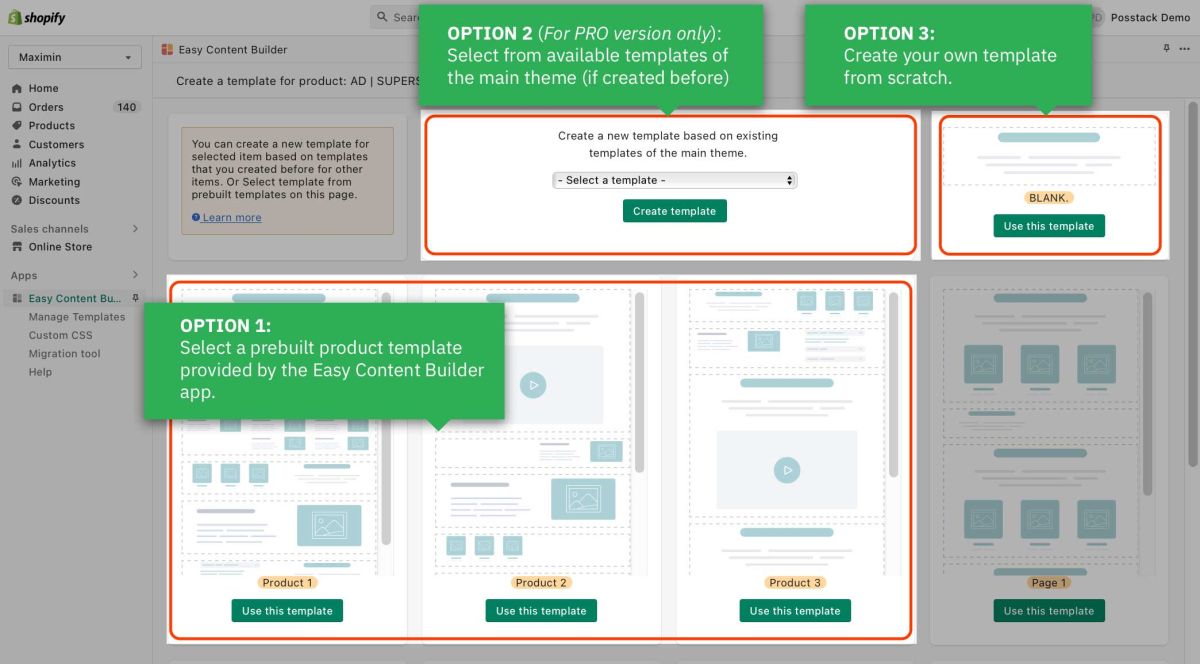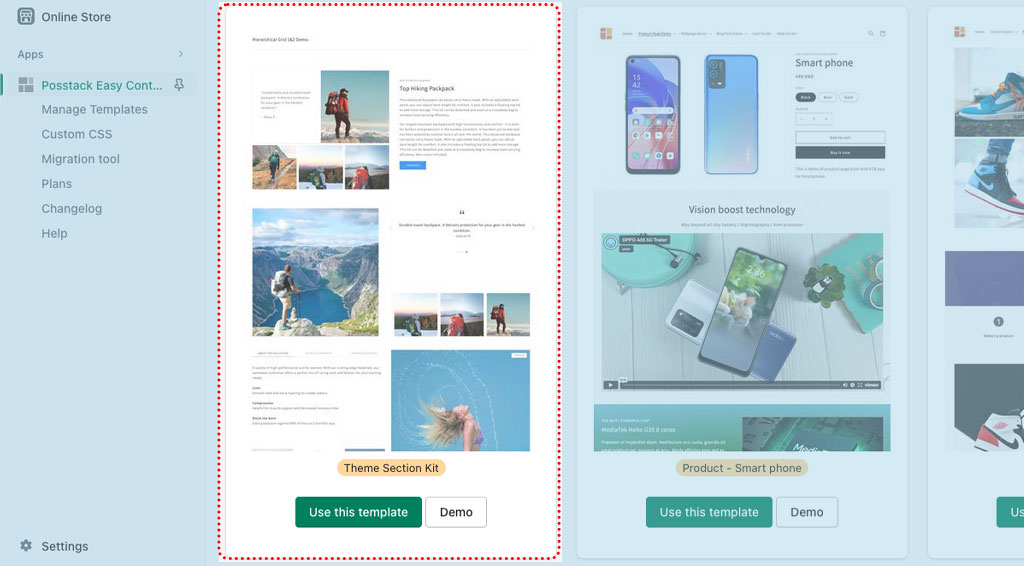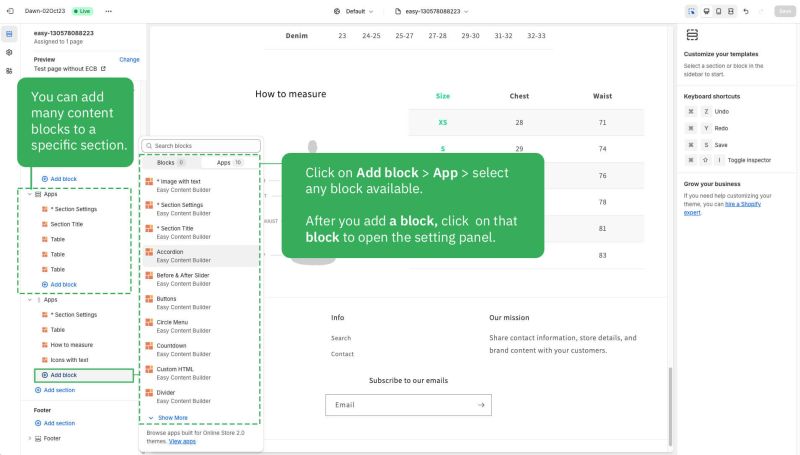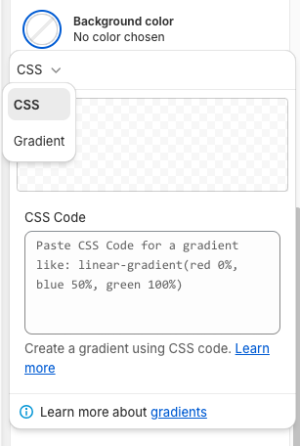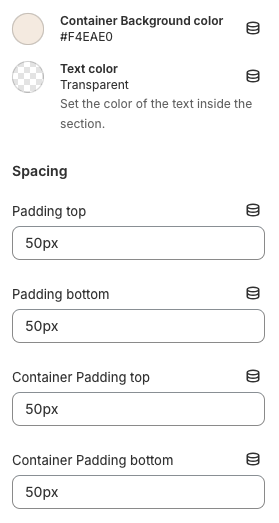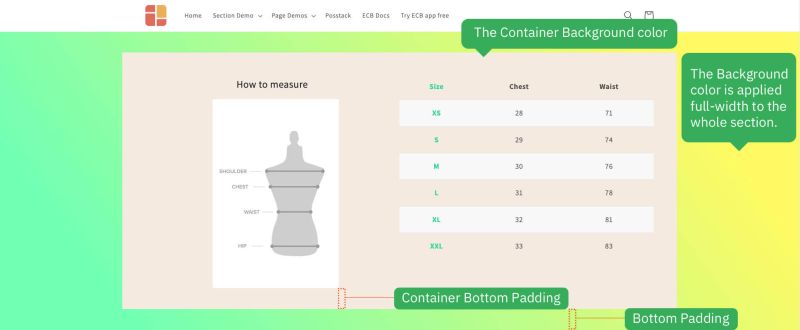Create Template For Single Page: Difference between revisions
| Line 53: | Line 53: | ||
[[File:Ecb-block-v2.jpg|border|frameless|800x800px]] | [[File:Ecb-block-v2.jpg|border|frameless|800x800px]] | ||
======Set the Text color====== | |||
The Text color setting is located in the Section Settings. Enter the HEX color value or choose from your currently used color (if any). Then, the new text's color will be applied to all content blocks within this section. | |||
[[File:Ecb text color.jpg|frameless|492x492px]] | |||
{{Note|Ensure you also update the Background Color or Container Background Color (under the same Section Settings panel) to pair with your new text's color. |reminder}} | |||
======Set the Background Color====== | |||
'''Step 1''': You can set the background color using '''CSS''' or '''Gradient'''. | |||
[[File:Ecb-bg-color-css.png|frameless|446x446px]] | |||
If you add a HEX color value using the CSS option and want to change to the Gradient color, just remove the HEX color and switch to the Gradient mode. | |||
[[File:Ecb-bg-color-gradient.png|frameless]] | |||
The background color will be applied full-width to the whole section. | |||
{{Note|Ensure you adjust the Text Color (under the same Section Settings panel) to keep the text visible and highly contrasting.|inline}} | |||
'''Step 2''' (Optional): Set the '''Padding Top'''/'''Padding Bottom''' (under the same Section Settings panel) to add desired horizontal space to the section. | |||
======Set the Container Background color====== | |||
[[File:Ecb-container-bg-color.png|frameless]] | |||
Use the Container Background Color setting to set the background color for the content area instead of the full-width background. You can define the background color using '''CSS''' or '''Gradient'''. | |||
{{Note|Ensure you set the Container Padding Top/Padding Bottom (under the same Section Settings panel) to add the desired horizontal space to the container. |inline}}[[File:Bg-container-demo.jpg|frameless|800x800px]] | |||
======Adjust the padding/margin of each section====== | ======Adjust the padding/margin of each section====== | ||
Revision as of 04:06, 26 February 2024
Getting Started
Overview
Templates are a collection of sections that are pre-built by Easy Content Builder. Once you add a template to your theme, you can add, edit, reorder, or remove any section within that template to customize your theme.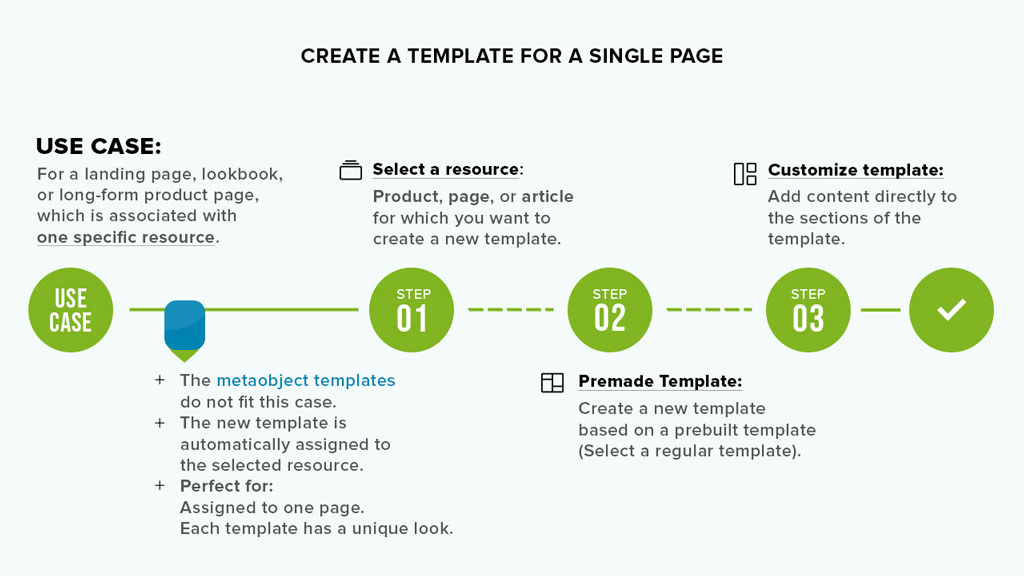
Tutorial Video
Watch this overview video to learn how to build a new template and assign it to an individual page using Easy Content Builder.
Adding your first template
Step 1: Select an item (Product/Blog Post/Page)
In your Shopify admin, select your Product/Blog Post/Page (depending on which page you want to create a custom template)
Step 2: Create a template
On the Product/Blog Post/Page, click on More actions > Create a template
Step 3: Choose a pre-made template
Select a prebuilt template suggested by the app (then you will be automatically redirected to the Theme Editor). Easy Content Builder offers you three options to create a new template:
- Select a prebuilt product template provided by the Easy Content Builder app.
- Select from available templates of the main theme (if created before): This option is only visible if you did build templates using the Easy Content Builder app before. It allows you to speed up the workflow by reusing those templates. Please note this option is available when you upgrade to the Pro version.
- Or create your own template from scratch.
- TIP: Create a clean template first to avoid a known issue - "Must have a maximum of 25 sections" and hide default sections of default template when creating page from prebuilt template.
- We suggest you install the Theme Section Kit to customize your Shopify theme faster. This template contains prebuilt sections (Free and Pro versions) that you can edit, reorder, or hide through your Theme Editor. Preview the Theme Section Kit here.
Step 4: Start customizing the template
Start adding and editing the app sections and blocks through your Shopify theme editor as follows:
Define your section column layouts
- With Easy Content Builder, you define the layout on an individual section level. This is done by adding/editing the Sections Setting block. Learn how to add a Sections Setting block.
- You can add many sections per page, each section with its column layout.
- Useful link:
- See multi-column layouts examples
- Learn how to create multi-column layouts
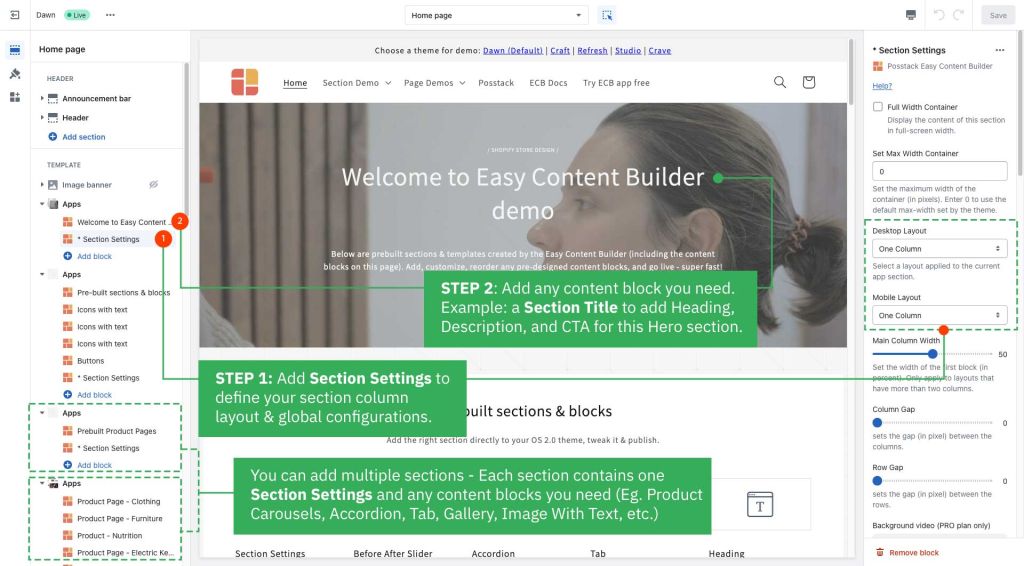
Add new blocks to that section as you wish
After adding a Section Settings, you can add many content blocks to the section you've created. These content blocks will be displayed in different positions within the section, depending on the Desktop/Mobile Layouts you configure.
Set the Text color
The Text color setting is located in the Section Settings. Enter the HEX color value or choose from your currently used color (if any). Then, the new text's color will be applied to all content blocks within this section.
Set the Background Color
Step 1: You can set the background color using CSS or Gradient.
If you add a HEX color value using the CSS option and want to change to the Gradient color, just remove the HEX color and switch to the Gradient mode.
The background color will be applied full-width to the whole section.
Step 2 (Optional): Set the Padding Top/Padding Bottom (under the same Section Settings panel) to add desired horizontal space to the section.
Set the Container Background color
Use the Container Background Color setting to set the background color for the content area instead of the full-width background. You can define the background color using CSS or Gradient.
Adjust the padding/margin of each section
- The Easy Content Builder lets you adjust the space (padding and margin) between elements at two levels:
- Section Settings level: refers to the global padding configurations for a section.
- Block level: refers to the padding/margin of a specific block within a section (One section might come with multiple blocks in it.)
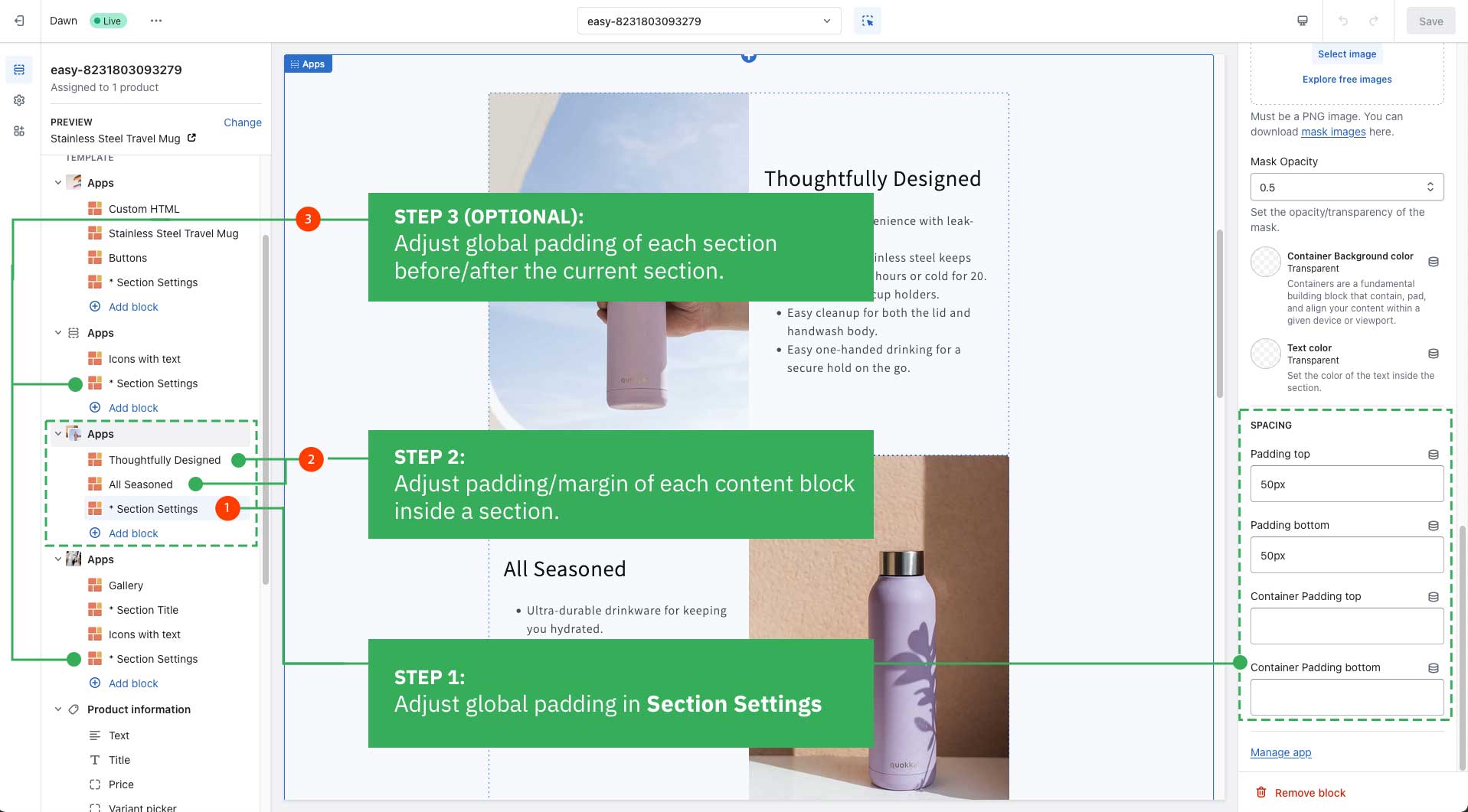
- The Easy Content Builder lets you adjust the space (padding and margin) between elements at two levels:
Adjust the font size, border radius, background color
- If you want to change your font size, button, background, border radius, etc., you can do so using the ECB's Custom CSS: 5-min video tutorial.
- For Pro plan: In addition to the standard Custom CSS feature, you have an Automatically Generate CSS option - a handy way to customize your theme without coding. Learn more.
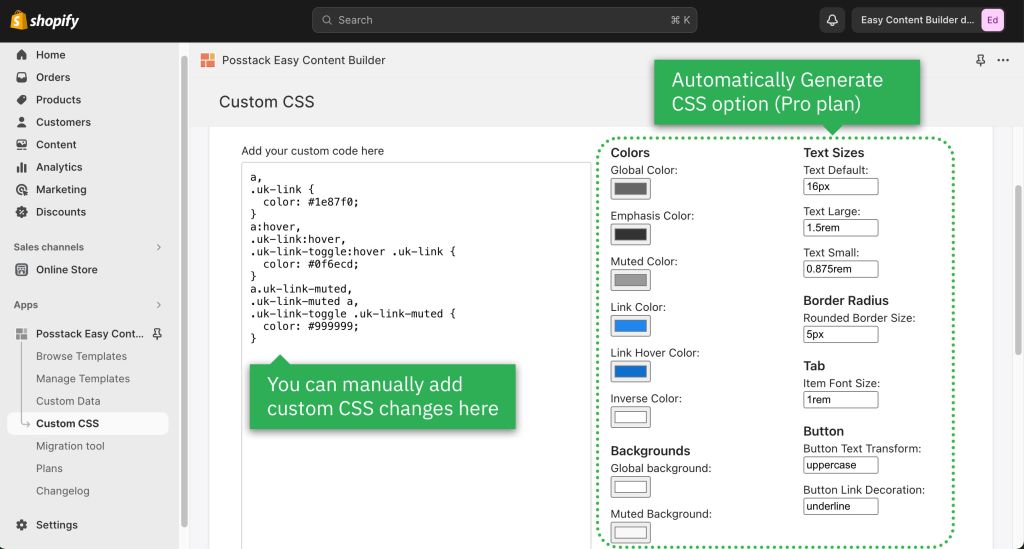
Preview your custom template
Steps to preview your products, blog posts or pages with the new custom template:
- From your Shopify admin, click Online Store > Themes.
- Find the theme that you want to edit, and then click Customize.
- Open the dropdown menu at the top of the page.
- Use the dropdown menu to select a template.
- In the sidebar, click Change.
- Select the product or page you want to preview with the selected template.
Next steps
Manage and edit your templates
- Manage your templates: follow these steps.
- Edit your template: follow these steps.
Set up multi-column layouts
- Learn how to set up multi-column layouts:
- 1-col boxed layout
- 1-col with Background Image
- 2-col with Flexible Col Width
- 2-col with Blank Sections
- Hierarchical Grids (6 layout options)
- We suggest you install the Theme Section Kit to customize your Shopify theme faster. This template contains prebuilt sections (Free and Pro versions) that you can edit, reorder, or hide through your Theme Editor. Preview the Theme Section Kit here.
Customize with Custom CSS
- Learn how to customize your Shopify themes with Custom CSS using Easy Content Builder: 5-min video tutorial.
- Do you want to change the primary, secondary, background color, font size, or border-radius? Refer to Custom CSS for more details on how to make those customizations.

